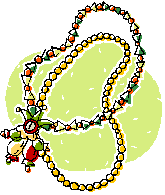



|
Wire Wrapping Tool Necessities
By Sonia Holt There are several tools of the beading trade that come in very handy, but three stand out as necessities: Round nose pliers (also known as chain nose pliers), needle nose pliers, wire cutters, also known as and side cutters. As nice as it is to have an array of tools, you can do all you'll ever need or want to do with these three tools. Trying to wrap wire without round nose pliers may not be crazy, but it's a close second. They are specifically designed to shape a piece of wire in uniform tight coils. They make wire wrapping far easier and faster, and are essential to completing beautiful wire wrapped jewelry. Needle nose pliers are great for getting into those tight places, but the work just as well for crimping a bead or tucking a cut end. Lastly, you certainly need side cutters in order to end wraps, develop a length of wire for a certain wrap and to clean up any sharp ends that won't tuck. All three should be at least average quality so that they will last and perform well. Tools made of soft steel, for example, will tend to become pitted, or the central hinge will not work smoothly over time, and the side cutters will not hold a sharp uniform cutting edge. All three tools should comfortably fit your hand. This is especially a problem for women since they tend to have smaller hands on average. It may be necessary to look at several brands and look for smaller tools. Failure to find a pair that is comfortable for your hand means that your hand will have to spread wider than normal just to make the tool work effectively. This tends to cause cramping over time. It is also important to find pliers and crimpers that have a spring in the hinge device so that they automatically open following each cut, wrap or crimp. This also prevents cramping because it eliminates the need to reopen the tool jaws with the little finger. Another important step is to make sure the tools have rubber- or plastic-coated handles so there are no sharp edges to cause blisters or other sore spots. Take care of your tools by keeping them lubricated with a little oil on occasion. Store them in a box, drawer or carrying case reserved just for them. This helps to prevent abrasion and wear. Keeping them in a carrying case makes it easy to grab them and go to another location for a beading session. If you're just starting out, be sure to put this tool trio in your tool kit first. Happy Beading! About the Author: For more tips and instructions as well as several simple patterns to get started, visit http://www.beadingguide.com |
|
|---|
Search the Web: 
Custom Search
|
Contact Us |
|---|